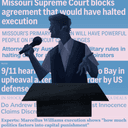As of January 17, 2018
In 2016, the Supreme Courts of Florida and Delaware declared their death-penalty statutes to be unconstitutional because they permitted trial judges to impose the death penalty based upon a sentencing jury’s non-unanimous recommendation for death. Those decisions left Alabama as the only state that permitted trial judges to impose a death sentences based upon a jury’s non-unanimous sentencing recommendation.
But Alabama is not the only state that permits judges to decide what sentence to impose if a capital-sentencing jury cannot reach a unanimous sentencing verdict. Missouri and Indiana consider the lack of unanimity to constitute a “hung jury” and then mandate that the court independently decide what sentence to impose if a capital-sentencing jury cannot reach a unanimous sentencing verdict.
No Missouri jury has imposed a death sentence since 2013, but Missouri state trial judges imposed death sentences in two cases in a four-month period between late 2017 and early 2018 under this hung-jury provision. In October 2017, a St. Charles County trial judge sentenced Marvin Rice to death after his jury deadlocked 11 – 1 in favor of a life sentence. In January 2018, a Greene County trial judge sentenced Craig Wood to death after his jury deadlocked 10 – 2 in favor of death.
DPIC has reviewed the death-penalty statutes of the 31 states that permit capital punishment and the federal death penalty statute to determine how each jurisdiction proceeds when a capital-sentencing jury does not reach a unanimous verdict in the penalty phase of a capital trial. This is what we found:
The laws of more than 70% of jurisdictions that permit capital punishment (22 states, plus the federal government) mandate an automatic life sentence if a jury cannot reach a unanimous sentencing verdict. Five states allow the state another opportunity to seek death with a new sentencing hearing before another jury. Two other states — Indiana and Missouri — remove the sentencing decision from the jury following a deadlock and transfer the decision-making authority to the judge. Another two states — Montana and Nebraska — reserve the sentencing power to the judge in all death-penalty cases.
Here is a state-by-state breakdown of the applicable law:
| JURISDICTION | WHAT HAPPENS IF JURY CANNOT REACH UNANIMOUS SENTENCE |
|---|---|
| Alabama | State Can Retry Multiple Times. (Alabama is the only state that permits a judge to impose the death penalty based upon a jury’s non-unanimous recommendation of death. Ten votes are required for a death recommendation. If the jury is not unanimous and fewer than ten jurors recommend death, the state can conduct a new sentencing hearing.) |
| Arizona | State Can Retry Once |
| Arkansas | Automatic Life |
| California | State Can Retry Multiple Times |
| Colorado* | Automatic Life |
| Florida | Automatic Life |
| Georgia | Automatic Life |
| Idaho | Automatic Life |
| Indiana | Judge Imposes Sentence (Can Be Death or Less) |
| Kansas | Automatic Life |
| Kentucky | State Can Retry Multiple Times |
| Louisiana | Automatic Life |
| Mississippi | Automatic Life |
| Missouri | Judge Imposes Sentence (Can Be Death or Less) |
| Montana | N/A — Judge Sentencing based on jury finding aggravating factors |
| Nebraska | N/A — Panel of judges decide sentence; if the panel is non-unanimous, then automatic life sentence |
| Nevada | Judge Either Imposes Life or Can Empanel A New Jury |
| New Hampshire* | Automatic Life |
| North Carolina | Automatic Life |
| Ohio | Automatic Life |
| Oklahoma | Automatic Life |
| Oregon | Automatic Life |
| Pennsylvania | Automatic Life |
| South Carolina | Automatic Life |
| South Dakota | Automatic Life |
| Tennessee | Automatic Life |
| Texas | Automatic Life |
| Utah | Automatic Life |
| Virginia* | Automatic Life |
| Washington* | Automatic Life |
| Wyoming | Automatic Life |
| U.S. Government | Automatic Life |
* State has since abolished the death penalty.
For an earlier survey of state practices, see Christopher Reinhart, Juries in Death Penalty Sentencing Hearings, Connecticut OLR Research Report 2005-R-0153 (February 2005)



